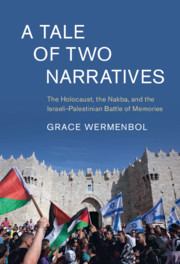Book contents
- A Tale of Two Narratives
- Cambridge Middle East Studies
- A Tale of Two Narratives
- Copyright page
- Dedication
- Epigraph
- Contents
- Figures
- Tables
- Acknowledgments
- A Note on Transliteration
- Abbreviations
- Introduction
- 1 The Post-Oslo Period
- Part I The Textbook of Memory
- Part II The Landscape of Memory
- Part III Scoop on the Past
- Conclusion
- Bibliography
- Index
- Series page
- References
Bibliography
Published online by Cambridge University Press: 14 May 2021
- A Tale of Two Narratives
- Cambridge Middle East Studies
- A Tale of Two Narratives
- Copyright page
- Dedication
- Epigraph
- Contents
- Figures
- Tables
- Acknowledgments
- A Note on Transliteration
- Abbreviations
- Introduction
- 1 The Post-Oslo Period
- Part I The Textbook of Memory
- Part II The Landscape of Memory
- Part III Scoop on the Past
- Conclusion
- Bibliography
- Index
- Series page
- References
Summary

- Type
- Chapter
- Information
- A Tale of Two NarrativesThe Holocaust, the Nakba, and the Israeli-Palestinian Battle of Memories, pp. 315 - 370Publisher: Cambridge University PressPrint publication year: 2021

